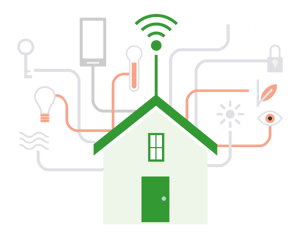Overview of Smart Sensors
IoT-powered smart sensors are revolutionising how local councils and housing associations monitor their managed properties. The wide range of data, including temperature, pressure, humidity, light and motion, is sent to devices like smartphones, tablets and back-end servers, providing real-time measurements, analysis and visualisation. Glasgow City Council, Stirling Council, Leeds City Council and Riverside Group have all jumped on the IoT bandwagon, recognising the potential for improved health and safety compliance, better services for residents and cost savings on proactive maintenance and repairs.

Smart sensors' readings combined with data stored in housing management systems (NEC, Civica, Orchard), CRMs (Salesforce, Microsoft Dynamics) and other platforms help achieve a 360-degree view of tenants, their patterns of activities and their living environment. The wealth of acquired information can be used to make informed decisions, monitor and analyse the energy consumption of buildings and appliances, as well as detect and alert for potential safety and security risks.
Benefits of smart sensors
Smart sensors have the potential to provide a wide range of benefits for social landlords and residents in terms of improved quality of life, cost-effectiveness, and enhanced security.
Improved Quality of Life
Intelligent sensors installed in social housing can help improve tenants' quality of life in various ways. By providing real-time information on the properties condition, landlords can identify areas needing repair and maintenance and ensure that these issues are dealt with quickly and effectively. Living in a safe, comfortable place positively impacts people's physical, mental and emotional well-being.
Sensors have been successfully utilised to detect unusual activity in and around properties, enabling councils and housing associations to respond quickly and effectively to potential safety or security issues. Monitoring air quality, temperature, and sound can help ensure comfortable houses and help detect potential hazards such as mould, gas leaks, and water damage.
Cost-effectiveness
 Social landlords can greatly reduce maintenance costs by detecting potential issues early, thus, preventing severe, expensive property damage and emergency repairs. The combined bill for housing associations in the UK reached a staggering £5.51bn in 2019/20. Research from the UK Housing Review suggests that around 10-20% of repairs and maintenance visits fail, costing social landlords an astonishing amount of money. Data received from sensors is analysed to understand behavioural patterns and identify times when tenants are likely to be at home, reducing the number of missed visits.
Social landlords can greatly reduce maintenance costs by detecting potential issues early, thus, preventing severe, expensive property damage and emergency repairs. The combined bill for housing associations in the UK reached a staggering £5.51bn in 2019/20. Research from the UK Housing Review suggests that around 10-20% of repairs and maintenance visits fail, costing social landlords an astonishing amount of money. Data received from sensors is analysed to understand behavioural patterns and identify times when tenants are likely to be at home, reducing the number of missed visits.
Sensors can alert residents about overheated rooms or dripping taps to help control energy consumption and reduce utility bills. Reducing the temperature by 1 degree could help a household save £80 per year. It would be especially beneficial for residents with low-income people. Higher gas and electricity prices have pushed the average annual energy bill in the UK to £1,277 a year, so any savings can make a difference to a household budget.
Enhanced security
 More than half of social housing tenants in the UK feel unsafe in their homes, according to the 'Social Housing Crime and Safety Survey' (2020). And almost a quarter have experienced at least one crime in the past year. Smart sensors can help address this issue by providing an additional layer of security. Early alerts of any suspicious activity help people feel safer in their homes. Data supplied by sensors can also be utilised to monitor occupancy, allowing for more efficient management of property resources.
More than half of social housing tenants in the UK feel unsafe in their homes, according to the 'Social Housing Crime and Safety Survey' (2020). And almost a quarter have experienced at least one crime in the past year. Smart sensors can help address this issue by providing an additional layer of security. Early alerts of any suspicious activity help people feel safer in their homes. Data supplied by sensors can also be utilised to monitor occupancy, allowing for more efficient management of property resources.
Shelter research revealed that over half of the social properties had required repairs in the last three years, while 70% of social tenants expressed concerns about the fire safety of their homes. Smart sensors can also help landlords meet their responsibility to maintain fire detection, as early alerts of smoke or carbon monoxide can save lives in the case of a fire or other emergency.
Challenges of utilising smart sensors for social housing
Cost of installation and maintenance
 While sensors have the potential to revolutionise the way we live, they also come with a set of challenges. The cost of investing in this technology includes installation, security, training and even upgrade of the existing infrastructure. In addition, the sensors need to be regularly maintained and monitored to ensure that they are functioning correctly, which can also add to the cost.
While sensors have the potential to revolutionise the way we live, they also come with a set of challenges. The cost of investing in this technology includes installation, security, training and even upgrade of the existing infrastructure. In addition, the sensors need to be regularly maintained and monitored to ensure that they are functioning correctly, which can also add to the cost.
Lack of standardisation
Another challenge is the lack of standardisation in the technology. Different types of sensors require different levels of expertise to install and maintain. Landlords may need to invest in additional staff training or outsource the whole function to an external partner organisation.
Data privacy
The use of sensors comes with a major concern about privacy. If not carefully secured and monitored, a huge amount of collected data could be taken advantage of by malicious actors. Despite the clear benefits of IoT devices, 84% of social housing residents are against them, mainly due to concerns over data privacy. Social landlords must ensure that collected information is kept safe and people's privacy is respected. This calls for solid security measures in data protection.
Conclusion
Intelligent sensors open new horizons for social landlords. Remote real-time monitoring and a wealth of collected data ensure a 360-degree view of the managed properties, improved decision-making and optimised energy consumption. Smart technology can help recognise, address and prevent potential hazards. With the right security measures in place, landlords can minimise the associated risks while realising the full benefits of the technology to improve the quality and safety of rented homes.







